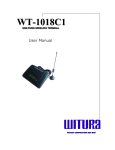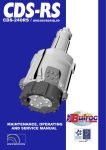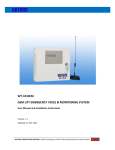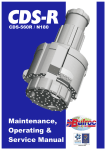Download Radio Shack XL-400 Specifications
Transcript
XL-110 Stereo Amplifier (120-2014) Features Faxback Doc. # 44361 Your Optimus XL-110 High Power Stereo Amplifier produces a total of 110 watts to give added punch and power to your vehicle's existing autosound system. The amplifier produces up to 55 watts per channel of clean, powerful sound at all audio frequencies with minimum distortion. You can connect your autosound system's low-level or speaker-level outputs to this amplifier. Its features include: 14K Gold-Plated Noise-Isolated Low-Level Input Jacks - let you connect lowlevel (preamplifier) signal inputs to match your autosound system's output for the best high-fidelity performance. 14K Gold-Plated Speaker Terminals - designed for low impedance, high conductivity, and minimum corrosion, to provide the highest signal transfer and lowest sound distortion. Input Level Control - lets you adjust the level of the audio signals that enter the amplifier. Automatic Power Switching - can automatically turn the amplifier on or off when you turn your autosound system on or off depending on how you hook up the amplifier). Mute Turn On Circuit - eliminates the thump you hear when you turn on some amplifiers. Power Indicator - lights when power is supplied to the amplifier. Crossover Frequency Circuit - lets you adjust the crossover frequency from 45-400 Hz. This lets you set up the amplifier so you can connect a subwoofer. Short Circuit Protection - distorts the amplifier's sound if any output channel shorts, alerting you to turn off the autosound system. Auto-Off - protects the amplifier by temporarily shutting down if it gets too hot or it detects an input overload. The amplifier restarts automatically when it cools or the problem is corrected. Protection Indicator - lights if the amplifier shuts itself down. XL-110 Stereo Amplifier (120-2014) Preparation Faxback Doc. # 44362 SUPPLIED HARDWARE Your amplifier comes with the following items. Be sure you locate everything before you store or dispose of the packing materials. Fuse 20A Power Wire (Red) (1) Ground Wire (Black) (1) Remote Wire (Blue/White) (1) 4-Pin Connector with Wire (1) Flat Washers (4) Sheet Metal Screws (4) Lock Washers (4) Twist-On Terminal Connector (5) BEFORE YOU BEGIN THE INSTALLATION Before you install your amplifier, read all the instructions. And, you should be able to answer all of the questions about your vehicle's electrical and autosound systems. Does my vehicle have an autosound system, such as a car stereo or CD player, already installed? (You must have an existing autosound system to use this amplifier.) How do I connect a wire to the fuse box? Which of the autosound system's wires is the power wire? Which of the autosound system's terminals are low-level outputs and which are high-level (speaker) outputs? Also, be aware that installation in your vehicle might require cutting or modifying your vehicle. Choosing a Mounting Location A good location for mounting the amplifier is in your vehicle's trunk. Wherever you decide to mount it, choose a mounting location that: Does not interfere with the vehicle's operation Lets you drill mounting holes without damaging other vehicle components Allows enough space around the cooling fins for proper airflow and cooling Lets you easily see the amplifier's POWER and PROTECTION indicators Warning: The amplifier gets very hot while it is on. Do not touch the amplifier or place flammable objects near it while it is on. Preparing the Mounting Area Before you mount the amplifier, make sure you have all the materials you need, such as an adapter harness, additional wire, shielded audio cables, and 16- or 18-gauge marked or color-coded wires. Then confirm that the amplifier fits in your vehicle's available mounting area. This amplifier requires a 5 1/2-inch (13.9 cm) high by 9 3/4-inch (23.5 cm) wide by 11 3/4-inch (29.8 cm) deep mounting area with adequate ventilation space. Routing Cables and Wires Avoid routing the connection cables and any speaker wires near moving parts or sharp edges. You can usually route wires and cables along the wiring channel beneath the vehicle's door facings by carefully removing the molding that holds the carpet in place. After routing the cables and wires, replace the molding. INSTALLATION ORDER For trouble-free installation, simply follow the instructions in order. First make all the connections by temporarily connecting the amplifier to: 1. 2. 3. Ground and power Your autosound system's outputs Your speakers Then test the connections. When you verify that everything works as expected, disconnect the amplifier, mount it in your vehicle, and reconnect it. Caution: If you do not make the connections in the order shown, damage to the amplifier and your autosound system is possible if any wire connections are made incorrectly. Note: For easier installation, mark each wire you plan to connect with the name of the terminal you will connect it to. BEFORE YOU MAKE THE CONNECTIONS The supplied connection cables include all the lead wires you need to connect the amplifier to ground, power, and your existing autosound system. Important: Do not cut these wires. If you cut any wire, you cannot obtain a refund or exchange on this product. However, RadioShack will provide warranty service if you cut a wire and find the product is defective. If the connectors on your vehicle's autosound system are not compatible with the amplifier's connectors, you might need an adapter harness to complete the connections. RadioShack stores sell adapter harnesses for most vehicles. You might need additional wire, depending on your individual autosound system, to complete the connections. Your local RadioShack store carries a full line of wire and wire management accessories. Cautions: For added safety and to protect your amplifier and autosound system, disconnect the cable from your vehicle's negative (-) battery terminal before you begin. Be sure your speaker can handle as much as 110 watts of power (55 watts per channel). Each speaker must have an impedance of at least 4 ohms. Your local RadioShack store carries a full line of speakers. To make it easier to gauge wire length and connect the amplifier, temporarily place the amplifier as close as possible to the selected mounting location. CONNECTING GROUND AND SWITCHED/PRIMARY POWER Follow these steps to connect the amplifier to ground, switched power, and primary power. 1. If you have not done so already, disconnect the cable from your vehicle's negative (-) battery terminal. 2. Use a screwdriver to connect the spade end of the supplied black ground wire to the amplifier's GND (ground) terminal. 3. Connect the black ground wire's other end to a chassis ground, such as a metal bolt attached to a metal part of the vehicle's frame. Be sure the bolt is not insulated from the chassis by a plastic part. 4. Use a screwdriver to connect the spade end of the supplied blue/white wire to the amplifier's REM (remote power) terminal. 5. Connect the blue/white wire's other end to your autosound system's switched power lead using one of the supplied twist-on terminal connectors. This connection turns on the amplifier when you turn on the autosound system, and turns off the amplifier when you turn off the autosound system. This prevents your vehicle's battery from being drained if you leave your amplifier on when you turn your autosound system off. If your autosound system does not have a switched power lead, connect the blue/white wire's other end to a point in your vehicle's fuse block that has power only when you turn on the ignition or turn the key to ACC. This connection turns on the amplifier when you turn on the ignition or turn the key to ACC, and turns off the amplifier when you turn off the ignition. This prevents your vehicle's battery from being drained if you leave your amplifier on when you turn off the ignition. 6. Use a screwdriver to connect the spade end of the supplied red power cable (with in-line fuse holder) to the amplifier's +12V terminal. 7. Connect the other end of the red power cable to your vehicle's positive (+) battery terminal. Then tighten the terminal. Caution: Due to the amplifier's high current requirement, you must connect the red power cable's fused end directly to the vehicle's positive (+) battery terminal or damage to your vehicle's wiring could result. Do not reconnect your vehicle's negative (-) battery cable yet. XL-110 Stereo Amplifier (120-2014) Connections Faxback Doc. # 44363 LOW-LEVEL INPUTS You can connect your autosound system's low-level line out jacks to the amplifier's low-level line in jacks. If your autosound system does not have low-level line out jacks, "High Level (Speaker Wire) Inputs" to connect your amplifier. Note: For the best results, use shielded audio cables such Cat. No. 42-2368 (not supplied). 1. Temporarily place the amplifier as close as possible to the selected mounting location. 2. If your autosound system has two line out jacks, connect the autosound system to the amplifier with the right line out jack being connected to the Low Input right jack, and the left line out jack being connected to the Low Input left jack. Note: If your autosound system has four separate line out jacks, use the autosound system's front left and right jacks to make this connection. HIGH-LEVEL (SPEAKER WIRE) INPUTS If your autosound system does not have low-level line out jacks but has only speaker outputs, connect your autosound system's speaker outputs to the amplifier's HIGH INPUT jacks. If your autosound system has four speaker outputs, see "Connection Diagrams," Faxback Doc. # 44405 to connect your system's speaker outputs to the amplifier using either a floating or common ground connection. If your autosound system has two speaker outputs, see "Connection Diagrams," Faxback Doc. # 44405 to connect your system's speaker outputs to the amplifier using either a floating or common ground connection. Note: A floating ground connection lets the amplifier provide more power to each speaker, but requires that you connect a separate wire to each speaker terminal. A common ground connection lets you use fewer wires to connect the speakers to the amplifier, but reduces the amount of power supplied to the speakers from the amplifier. Use the supplied wire harness and the supplied twist-on terminal connectors to make the appropriate connections. CONNECTING SPEAKERS You can connect two speakers or a subwoofer to the amplifier and your autosound system. If you are connecting two speakers, follow steps 1-3 under "Preparing the Speaker Wires" then see "Connecting a Subwoofer" to connect the subwoofer to the amplifier. Preparing the Speaker Wires Caution: You must connect a separate wire to each speaker terminal as described in the following procedures. Only use a common ground wire or chassis ground if your autosound system is wired for it. Notes: We recommend you use 16- or 18-gauge marked or color-coded wires to help you correctly connect the speakers to your amplifier. Color coded wires have a stripe running down one of the conductors or different colored insulation for each conductor. Your local RadioShack store has a wide selection of speaker wire to choose from. For the maximum bass response and the best overall performance, keep your speakers properly phased (connect + to + and - to -). 1. With the speakers placed in their approximate locations, run one wire from each speaker to the amplifier. 2. Separate each wire's two conductors at both ends for a length of about 4 inches. 3. Strip the insulation from the ends of each conductor to expose 1/4 inch of wire. Twist the ends to secure loose strands. Connecting Two Speakers 1. Use a screwdriver to connect the left speaker's positive (+) wire to the amplifier's SPEAKER L (+) terminal. 2. Use a screwdriver to connect the left speaker's negative (-) wire to the amplifier's SPEAKER L (-) terminal. 3. Repeat steps 1-2 to connect the right speaker's positive (+) and negative (-) wires to the amplifier's SPEAKER R (+) and SPEAKER R (-) terminals. Connecting a Subwoofer 1. Use a screwdriver to connect the subwoofer's positive (+) wire to the amplifier's SPEAKER L (+) or SPEAKER R (+) terminal. 2. Use a screwdriver to connect the subwoofer's negative (-) wire to the amplifier's negative (-) terminal for the same channel you connected in step 1. For example, if you connected the subwoofer's positive (+) wire to the amplifier's SPEAKER L (+) terminal, connect the subwoofer's negative (-) wire to the amplifier's SPEAKER L (-) terminal. COMPLETING THE INSTALLATION Before you continue, make sure you have securely made all connections. Then reconnect the cable to the vehicle's negative (-) battery terminal. Set LEVEL (MIN/MAX) on the amplifier to its mid position. Then turn on your vehicle's ignition and autosound system to confirm that the amplifier and autosound system operate properly. The amplifier turns on after a few seconds. If you cannot quickly confirm whether the autosound system and amplifier are working properly, turn off your vehicle's ignition and disconnect the cable from your vehicle's negative (-) battery terminal. Then recheck your connections. After you test the autosound system and amplifier and verify that everything is properly connected and working, follow the instructions in "Mounting the Amplifier." MOUNTING THE AMPLIFIER Once you verify that the amplifier is connected properly, follow these steps to mount it. 1. Disconnect the cable from the vehicle's negative (-) battery terminal. 2. To make mounting more convenient, temporarily disconnect the amplifier's connections (ground, primary power, remote power, your autosound system's input, and speakers). Note: If you have not already done so, be sure to mark each wire with the name of the terminal you will reconnect it to. 3. Using the mounting holes on the amplifier as a guide, mark the positions for the mounting holes. 4. Drill 9/64-inch (3.57 mm) holes at the marked locations, being careful not to damage anything behind the mounting surface. 5. Secure the amplifier to the mounting surface using the supplied sheet metal screws and washers. 6. Reconnect the wiring. 7. Reconnect the cable to the vehicle battery's negative (-) terminal. 8. Reset your vehicle's clock, your autosound system's tuner memory, and other timer/memory devices. XL-110 Stereo Amplifier (120-2014) Operation Faxback Doc. # 44364 TURNING ON THE AMPLIFIER The amplifier automatically turns on a few seconds after you turn your vehicle's ignition switch to ACC or ON or turn on your autosound system, depending on how you wired the system. The POWER indicator on the side of the amplifier lights when the amplifier is on. Important: Note: Your amplifier requires 17 amps or more of power from your vehicle's battery during operation. To protect your battery from discharging, do not operate the amplifier unless your vehicle is running. Your amplifier temporarily shuts down if it gets too hot, then restarts automatically once it cools. ADJUSTING THE AUDIO LEVEL For the best performance, you must set LEVEL (MIN/MAX) on the amplifier to adjust the level of the audio signals that enter the amplifier. 1. Use a screwdriver to turn LEVEL (MIN/MAX) fully counterclockwise to MIN. 2. Turn the autosound system's volume control to about one-third of its full range. 3. Adjust LEVEL (MIN/MAX) to a comfortable listening level. 4. Turn up the autosound system's volume control until the sound begins to distort. Then immediately turn the volume down to a point just before where the distortion began. Caution: Never turn up the autosound system's volume control more than needed to adjust the audio level, or more than two-thirds of its maximum volume. 5. Adjust LEVEL (MIN/MAX) until the sound is at the maximum level you want the amplifier to produce. 6. Adjust the autosound system's volume control to a comfortable listening level. ADJUSTING FREQUENCY CROSSOVER If you installed a subwoofer using the steps in "Connections," Faxback Doc. # 44363, set X-OVER FREQ ON/OFF to ON, then adjust X-OVER FREQ for your particular vehicle's acoustics. The amplifier passes through all frequencies at or below that setting (45-400 Hz). Note: X-0VER FREQ selects the limit at which the amplifier will pass frequencies (from 45-400 Hz). You should not use it to adjust the sound you hear through your main speakers. XL-110 Stereo Amplifier (120-2014) Troubleshooting Faxback Doc. # 44365 We do not expect you to have any problems with your Optimus XL-110 High Power Stereo Amplifier, but if you have a problem, this chart might help. If it does not, take the amplifier to your local RadioShack store for assistance. SYMPTOM POSSIBLE CAUSE SUGGESTION No power - the amplifier's POWER indicator does not light after the vehicle's autosound system is turned on. Power problem. Check the amplifier's and autosound system's fuses and replace them if necessary. Vehicle's ignition not turned on. Start the vehicle. Amplifier not connected to autosound system/ vehicle correctly. Check all connections. Autosound system not turned on or volume set to minimum. Turn the autosound system on or adjust its volume. Amplifier's LEVEL (MIN/MAX) control set to minimum. Adjust LEVEL (MIN/MAX). Amplifier not connected to autosound system/ vehicle correctly. Check all connections. The amplifier might have shut down. Turn your autosound system off and let the amplifier cool. Make sure the amplifier is properly ventilated. Then turn your autosound system back on. The amplifier turns itself back when it is cooled. No sound. The amplifier detected an input overload. Reduce the autosound system's volume. Distorted sound. The amplifier's PROTECTION indicator lights. Power problem. Check the amplifier's and autosound system's fuses and replace them if necessary. The amplifier might be receiving too much input power from your autosound system. Reduce your autosound system's output power (if possible), or reduce the autosound system's volume. An output channel might have shorted. Take the amplifier to your local RadioShack store. The amplifier might have shut down. Turn your autosound system off and let the amplifier cool. Make sure the amplifier is properly ventilated. Then turn your autosound system back on. The amplifier turns itself back on when it is cooled. Amplifier not connected to autosound system correctly. Check all connections. The amplifier might be receiving too much power from your autosound system. Reduce your autosound system's output power (if possible), or reduce the autosound system's volume. XL-110 Stereo Amplifier (120-2014) Care and Maintenance Faxback Doc. # 44366 Your Optimus XL-110 High Power Stereo Amplifier is an example of superior design and craftsmanship. The following suggestions will help you care for your amplifier so you can enjoy it for years. Keep the amplifier dry. If it gets wet, wipe it dry immediately. Liquids might contain minerals that can corrode the electronic circuits. Keep the amplifier away from dust and dirt, which can cause premature wear of parts. Handle the amplifier gently and carefully. Dropping it can damage circuit boards and cases and can cause the amplifier to work improperly. Wipe the amplifier with a damp cloth occasionally to keep it looking new. Do not use harsh chemicals, cleaning solvents, or strong detergents to clean the amplifier. Modifying or tampering with the amplifier's internal components can cause a malfunction and might invalidate your amplifier's warranty and void your FCC authorization to operate it. If your amplifier is not performing as it should, take it to your local RadioShack store for assistance. THE FCC WANTS YOU TO KNOW Your amplifier might cause TV or radio interference even when it is operating properly. To determine whether your amplifier is causing the interference, turn off your amplifier. If the interference goes away, your amplifier is causing it. Try to eliminate the interference by: Moving your amplifier away from the receiver Contacting your local RadioShack store for help REPLACING A FUSE If the amplifier does not operate, you might need to replace the red power cable's 20-amp SFE-type fuse or the 20-amp blade-type fuse on the amplifier's back panel. Check both fuses. Important: Let the amplifier cool down and see if starts again before you assume a fuse needs to be replaced. Caution: Do not use a fuse with ratings other than those specified here. Doing so might damage your amplifier. Replacing the SFE-Type Fuse 1. Disconnect the cable from the vehicle's negative (-) battery terminal. 2. Push together and twist the fuse holder's parts on the red power cable until they spring apart. Then remove the fuse. 3. If the fuse is blown, replace it. Use only an SFE-type fuse with the proper rating (such as Cat. No. 270-1074). The fuse must be 20 amps. 4. Reassemble the fuse holder by inserting the fuse into the longer of the fuse holder's ends, and pushing together and twisting the two parts until they latch together. 5. Reconnect the cable to the vehicle's negative (-) battery terminal. Replacing the Blade-Type Fuse 1. Disconnect the cable from the vehicle's negative (-) battery terminal. 2. Grasp the fuse's plastic end and pull it out. 3. If the fuse is blown, replace it. Use only a blade-type with the proper rating (such as Cat. No. 270-1083). The fuse must be 20 amps. 4. Grasp the new fuse's plastic end and push it in. 5. Reconnect the cable to the vehicle's negative (-) battery terminal. XL-110 Stereo Amplifier (120-2014) Specifications Faxback Doc. # 44367 Output Power................. 35 Watts x 2 @ 4 Ohms, 20-20 kHz, 0.5% THD 55 Watts x 2 @ 4 Ohms, 20-20 kHz, 10% THD 40 Watts x 2 @ 2 Ohms, 20-20 kHz, 1% THD Frequency Response............................... 20-20,000 Hz (+/-3 dB) Power Supply Voltage........................... 14.4 VDC Negative Ground Maximum Current Draw............................................... 20 A Dimensions (HWD)............................ 2 1/16 x 9 x 10 9/16 Inches (5.2 x 23 x 26.8 cm) Net Weight......................................... 3 lbs 15 oz (1.4 kg) Specifications are typical; individual units might vary. are subject to change and improvement without notice. (km-09/24/97) LN-03/04 Specifications


























